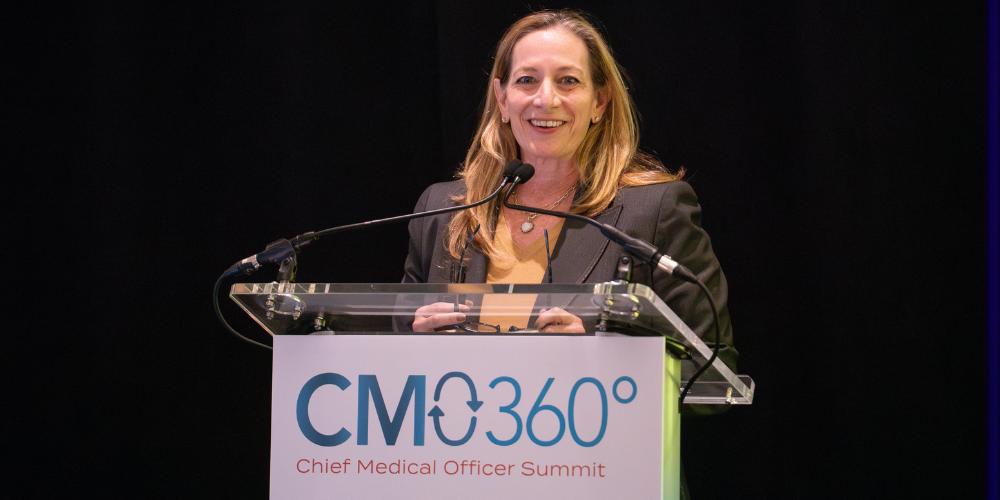Breaking Down the Cost of Cell Therapies and Current Solid Tumor Work with BMS’s Dr Teri Foy
Teri Foy, PhD, uses her expertise and BMS’ success in CAR T cell therapies to outline current challenges in cell therapy costs and the solutions on the horizon. She is SVP, Research and Early Development Immuno-Oncology and Cell Therapy, at BMS, focused on the development and translation of BMS’ early IO and cell therapy pipeline from discovery through human proof of concept.

What are your biggest concerns around rising costs for cell therapies?
What’s important to think about concerning the costs of cell therapies is that bringing costs down will increase our ability to deliver these therapies to more patients. The biggest challenge with the current generation of cell therapies is that they are very labor-intensive to manufacture, in three ways. Firstly, they are autologous products made for each individual patient, which adds time and complexity to manufacturing. Secondly, much of the process is manual; it relies on individual manipulations of cells. And thirdly, it's dependent on viral vectors to deliver the genetic materials needed to engineer the CAR and the other features to the cells.
Each of those things adds to the expense of manufacturing: when you scale up to deliver to thousands of patients, you compound those costs. So as we're working to reduce costs, we're looking at each of those different pieces to try to reduce those costs.
What are the topline hurdles in addressing cost for the next generation of cell therapies?
If we take autologous versus other cell sources: one of the biggest hurdles is in biology. When using a patient’s own cells, you don't have to worry about those cells being rejected by the patient because they are their own cells. If you're using an allogeneic cell therapy, those cells come from a healthy donor, but you have to figure out how to engineer them such that when they're given to the patient, they're not rejected, or that they don't attack the patient’s tissues. Even when we go to iPSC-based therapies, which offer some advantages in that we are able to build a master cell bank which enables additional manipulations and engineering; you still have to engineer out those foreign, allogeneic components. Saying “off the shelf” sounds great, but there are big biological hurdles to overcome for “off the shelf” therapies to be as successful as autologous therapies.
We’ve seen companies moving forward with allogeneic products, and we’re seeing decent efficacy. The question is: will it be durable? It’s not yet demonstrated that it's as good as autologous therapy. Will we be able to bridge that gap?
What questions are you asking to be able to move forward with reducing costs?
Can we do more automation? Can we look at ways to decrease the cost of the viral vector or eventually move away from dependency on viruses to deliver the cargo? Can we engineer cells using non-viral delivery mechanisms? Can we move away from autologous cells as the source of cells? Each of those pieces could contribute to driving down the costs eventually. But with that goal of reducing costs is maintaining and even increasing the efficacy and safety profile of the cell therapy.
Why do you think we need to examine the potential for non-viral vectors to get costs down?
In some ways, we have been a victim of our own successes with CAR T cell therapies. Vector manufacturers have been challenged to supply the market at pace with the demand from manufacturers, so we are trying to figure out ways to diversify our supply.
Then, automation. While there are components of automation already, end-to-end automation that is reliable, closed and offers stability takes a while to build. I feel like the success of the first commercial products perhaps got ahead of the infrastructure needed to support scaling for the demand.
"We're learning what needs to be overcome to serve patients who may not be responding, as well as how to improve our manufacturing to make sure we are delivering the best products we can."
Do you think we’re on the right track to lowering costs?
We've made good progress. Each of the companies launching a CAR T cell therapy, from the first one until now, has learned from the previous ones. We as BMS are learning from our manufacturing experiences and clinical translational data. We’ve learned that while the data you collect during a clinical trial can absolutely inform and predict which patients could benefit, when you get into the real world, there is much more patient heterogeneity. Doctors can prescribe CAR T to any patient who fits into the label.
It is an opportunity to serve more patients, but those patients may be more sick than the patients in your clinical trials, or they may have different disease characteristics and profiles. We're learning what needs to be overcome to serve patients who may not be responding, as well as how to improve our manufacturing to make sure we are delivering the best products we can.
Switching gears, what is the overview of BMS’ past work in cell and gene therapies?
BMS has a legacy of pioneering in this space. We are the first and only company that has two approved CAR T cell therapies with two distinct targets: Breyanzi, targeting CD19, and Abecma, the first cell therapy targeting BCMA and the first to treat multiple myeloma. With those two approved CAR T cell therapies, we feel like we've pioneered the space, treating this unmet need of patients with cell therapies.
Breyanzi, which is the lymphoma CAR T cell therapy, has become a transformative therapeutic option for large B-cell lymphoma in the third-line plus setting, and in the second-line setting, showed that it has superior activity over salvage chemotherapy followed by transplant, a standard of care that has been in place for nearly 30 years. It’s something we're very proud of. We now have the broadest label for treating lymphoma patients with any CD19 directed CAR T cell therapy. In myeloma, Abecma is the first CAR T cell therapy available for triple-class exposed patients with relapsed or refractory multiple myeloma, and now is showing in the clinical trial setting superiority versus standard-of-care regimens in patients who had 2-4 prior lines of therapy.
How does that background influence your current and future work in cell therapies?
We have a very strong foundation of building these commercial CAR T cell therapies with Breyanzi and Abecma. We think that BMS has the opportunity to build on that foundation by taking our learnings from treating thousands of patients with CAR T cells, and using the extensive translational data that we're collecting along with clinical data and manufacturing data to learn how we can improve on these therapies. We want to improve upon building next-generation therapies in blood cancers, to treat the patients who are either not responding or who are relapsing.
We also want to build beyond that, expanding our expertise into cell therapies: the next generation of cell therapies and bringing costs down to increase our ability to deliver more of those therapies to more patients.
Abecma and Breyanzi are both for blood tumors. BMS recently announced building on its partnership with Immatics for the development of their candidate IMA401 for solid tumors. Can you tell us about BMS’ work in solid tumors?
The success of cell therapies in blood cancers is tremendous and transformational for patients. We are excited to build on those learnings and move that success into solid tumors. We have a number of programs and a number of partnerships, Immatics being one. They have identified T-cell receptors for different solid tumor targets. They've actually gone as far as to show that those antigens on the tumor cells are there in high-enough density so the T cells can recognize them.
Instead of a CAR T cell, where you've got an antibody-like binder recognizing a cell surface protein, here you've got a TCR binder recognizing an intracellular protein that's presented on a tumor cell. That gives you an opportunity to look at different kinds of targets. Only about a quarter of targets are present on the surface of tumor cells, but the vast majority of targets are intracellular targets and are present on the cell surface in a different way that allows them to be recognized by TCRs. That gives us an advantage in solid tumors to look for different targets.
What is a challenge you’re facing in solid tumors?
One challenge is finding good targets. A lot of the antigens expressed on solid tumors are also expressed in normal tissues. In blood cancers, the antigens that CAR T cells target are also on normal cells, B cells and plasma cells, but these cells can be regenerated.
That’s not as true in normal tissues; you don’t necessarily want to hit a normal tissue with your CAR T cells. For solid tumors, it's often difficult to find a target that's not expressed on the same normal tissue, and you don’t want your CAR T cells to kill that normal tissue. Therefore, you have to look for ways to differentially recognize the tumor tissue from the normal tissue.
How do you solve a problem like that?
One thing you can do is use a logic gate: “I’ll look for a target that is here, but not there.” Or “If it is here, it will only trigger expression of the CAR if it’s also on the tumor.” That’s what we’re doing with our partnership with Arsenal. They're looking at building logic gates to help give better selectivity on targets that are on the tumor and not the normal tissue.
Another factor is the solid tumor microenvironment is more complex. You have more suppressive factors in the tumor. In addition, access to the tumor is more difficult than in blood.
Those are some of the challenges that you have to think about when you're building CAR T cells for solid tumors. It takes more complex engineering to build in features that are going to work for solid tumors. We can build on a lot of learnings that we've gained through our work in blood cancers.
What do you view as the biggest knowledge gap in tackling solid tumors?
Targets and trafficking of the CAR T cell are both big challenges. Trafficking is important because if the cells stay in a patient’s bloodstream and don't get to the tumor, they're not going to expand. In myeloma and lymphoma, they expand hugely, because they're seeing the target antigen right away. After CAR T cell infusion, 70-80% of T cells in the blood can be CAR T cells. In solid tumors, we don't see expansion like that. Now, you might not need 70-80% of cells to be the CAR T cell, but you need a good portion of them, at least initially, to be able to see the antigen in the right spot and expand to be able to kill the target tumor cells.
Target selectivity is the other challenge. Some of the very early work in CAR T cells with a target like HER2 showed on target/off-tumor toxicity in the lungs. It was known that HER2 was expressed there, but it was the extent of the inflammatory response due to CAR T activation that was unexpected.
Realistically, what does the next 5-10 years look like in cell therapy? How do we get there and what challenges could be in the way?
In the next 5-10 years, we will see continued progress on bringing more cell therapies to more patients. Key aspects of this include improvements in CD19 and BCMA-directed therapies, potentially addressing patients who relapse after initial response, and companies being even better equipped to meet the demands of the market by increasing efficiency in cell therapy manufacturing. Importantly, I believe we’ll begin to see more significant progress in advancing cell therapies in solid tumors as we identify more strategies to successfully tackle the challenges in this area.





